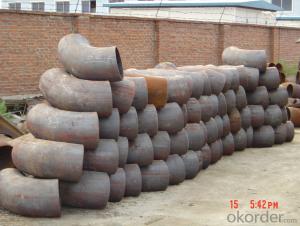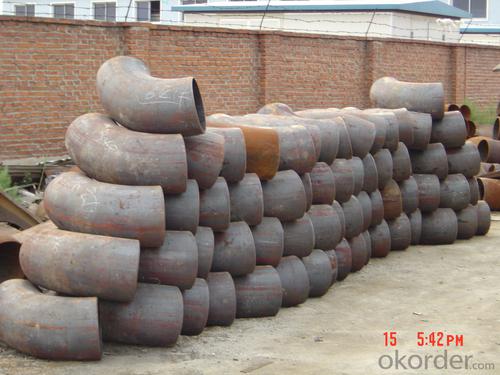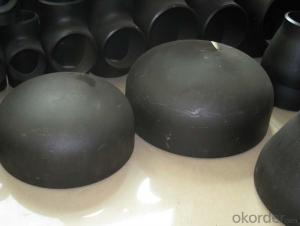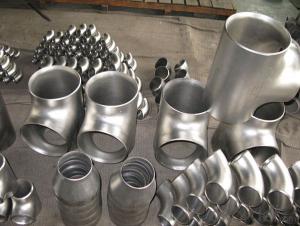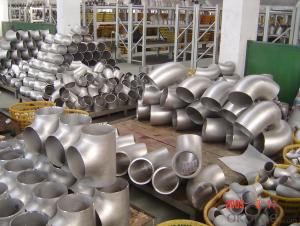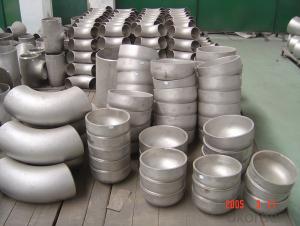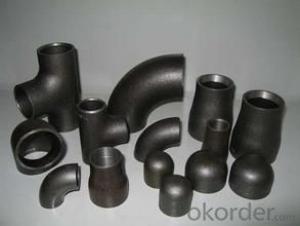CARBON STEEL PIPE BUTT WELDED FITTING A234 WPB B16.9
- Loading Port:
- Tianjin
- Payment Terms:
- TT OR LC
- Min Order Qty:
- 1 pc
- Supply Capability:
- 10000 pc/month
OKorder Service Pledge
OKorder Financial Service
You Might Also Like
Package Of Carbon Steel Butt-Welded Fitting:
PACKED IN PLYWOOD CASES OR PALLETS
Painting Of Carbon Steel Butt-Welded Fitting:
BLACK PAINTING FOR CARBON STEEL
Marking Of Carbon Steel Butt-Welded Fitting:
REFER TO MARKING DOCUMENT or AS PER CUSTOMER REQUEST
Shipping Marks Of Carbon Steel Butt-Welded Fitting:
EACH WOODEN BOX TWO PLASTIC SHIPPING MARKS
Specification Of Carbon Steel Butt-Welded Fitting:
Carbon Steel A234 WPB 90Deg LR Elbow, Tee, Reducer and Cap
Size : 1/2"-48"
Wall Thickness.: SCH10-SCH160, SGP , XS, XXS, DIN ,STD
| Name | ASTM A234 WPB carbon steel ELBOW , tee , reucer, and cap |
| Size | 1/2" - 48" |
| Angle | 45D 90 D 180D |
| Wall thickness | Sch5-Sch160 XXS,STD,XS, SGP |
| Standard | ASME B16.9, GOST 17375-2001, DIN2605 and JIS B2311, EN10253-1 etc. |
| We can also produce according to drawing and standards provided by customers. | |
| Material | Carbon steel pipe fittings , alloy steel and stainless steel. |
| Packaging | Wooden Cases, wooden pallet , or carton box , or nylog bag and then in wooden cases |
| Surface Treatment | Paintting black color , and Shot blasted,anti-rust oil , |
| Delivery Time | 20-30 days, after received advance payment. |
| Quality | First grade |
| Others | 1.Special design available according to your drawing. |
| 2.anti-corrosion and high-temperature resistant with black painting | |
| 3. All the production process are made under the ISO9001:2000 strictly. | |
| 4. A conformity rate of ex-factory inspection of products. | |
| 5. we have export right , offering FOB , CNF CIF price |
STANDARD & MATERIAL GRADE
STANDARD Of Carbon Steel Butt-Welded Fitting
| Standard | Wall Thickness | Type | |
| American Standard | ASME B16.9 | S5S ~ XXS | 45D, 90D, 180D ELBOW, TEE, REDUCER, CAP, STUB END |
| ASME B16.11 | |||
| ASME B16.28 | 90D SR ELBOW | ||
| Japanese Standard | JIS B2311 | SGP ~ LG |
MATERIAL Of Carbon Steel Butt-Welded Fitting
| Carbon Steel聽 | ||
| Material Standard | Material Grade | |
| ASTM | ASTM A234 | WPB |
- Q: What are the different types of supports used for steel pipes in buildings?
- Steel pipes in buildings commonly utilize various types of supports. These supports serve different purposes and are typically made of metal or plastic materials. Firstly, pipe hangers are designed to bear the weight of the pipe. They are securely attached to the building structure and prevent the pipe from sagging or shifting. Pipe clamps, on the other hand, are employed to fasten the pipe to a wall or other structural element. These clamps consist of a metal band that encircles the pipe and is then fixed to the structure using bolts or screws. Their main function is to provide stability and prevent any movement or vibration of the pipe. For distributing the weight evenly and offering additional support, pipe shoes are installed beneath the pipe. These support devices are typically made of metal or rubber and can be attached to the building structure or embedded in concrete foundations. To guide the movement of the pipe and prevent excessive bending or shifting, pipe guides are utilized. These guides, usually composed of metal or plastic, are installed at regular intervals along the length of the pipe. Lastly, pipe rollers are employed to support horizontal pipes and permit expansion and contraction due to temperature changes. Made of metal, these rollers allow the pipe to move freely without causing any harm to the building structure. It is crucial to select the appropriate type of support based on the specific requirements of the steel pipe and the building structure. By properly supporting steel pipes in buildings, their stability, durability, and overall safety are ensured.
- Q: Are steel pipes suitable for use in coastal areas?
- Yes, steel pipes are suitable for use in coastal areas. Steel is highly resistant to corrosion and can withstand the harsh environmental conditions typically found in coastal regions, such as saltwater spray and high humidity. Additionally, steel pipes offer excellent structural strength, making them well-suited for various applications including marine construction, offshore oil and gas platforms, and coastal infrastructure projects.
- Q: What is the pressure rating of steel pipes?
- The pressure rating of steel pipes can vary depending on factors such as the size, wall thickness, and specific grade of the steel used. However, steel pipes are commonly available in pressure ratings ranging from a few hundred PSI (pounds per square inch) to several thousand PSI, making them suitable for a wide range of applications.
- Q: How are steel pipes measured and labeled?
- Steel pipes are typically measured and labeled based on their diameter, wall thickness, and length. The diameter is measured in inches or millimeters, while the wall thickness is often expressed in inches or schedule numbers. The length is usually specified in feet or meters. Additionally, steel pipes may also bear labels indicating the type of steel used, industry standards compliance, and any specific certifications or markings required.
- Q: 304 stainless steel tube with the diameter of 25*2-3 is what mean
- The quality of the steel pipe should be in line with the national standard "stainless steel seamless pipe for fluid transportation" (GBT 14976-2012) requirements.
- Q: How are steel pipes used in industrial manufacturing processes?
- Steel pipes are commonly used in industrial manufacturing processes for various purposes such as transporting fluids, gases, and solids, as well as providing structural support. They are used in industries like oil and gas, construction, automotive, and chemical manufacturing. Steel pipes offer high durability, strength, and resistance to corrosion, making them ideal for handling harsh environments and high-pressure applications. Additionally, they can be easily welded, bent, and manipulated to fit specific requirements, allowing for efficient and cost-effective installations.
- Q: How are steel pipes used in the water treatment industry?
- Steel pipes are widely used in the water treatment industry for various applications. They are commonly used as conduits to transport water from different sources to treatment plants and distribution systems. Steel pipes are also employed in the construction of water treatment facilities, including filtration units, pumping stations, and storage tanks. Additionally, steel pipes are utilized in the distribution network to deliver treated water to consumers. The durability and strength of steel make it an ideal choice for handling the high pressure and corrosive conditions often present in water treatment processes.
- Q: What are the factors affecting the price of steel pipes?
- There are several factors that can affect the price of steel pipes. Some of the key factors include the cost of raw materials such as iron ore and other metals, energy prices, labor costs, transportation costs, and market demand and supply dynamics. Additionally, currency exchange rates, government regulations, and trade policies can also impact the price of steel pipes in the global market.
- Q: What are the different methods of heat treatment for steel pipes?
- There are several methods of heat treatment for steel pipes, including annealing, normalizing, quenching, tempering, and stress relieving.
- Q: Are steel pipes resistant to UV degradation?
- In general, steel pipes lack resistance to UV degradation. When exposed to ultraviolet (UV) radiation for extended periods, steel pipes may experience different types of degradation. The steel can become prone to brittleness, resulting in cracks and potential failure. Moreover, UV radiation can induce corrosion and discoloration on the surface of the steel pipes. To counteract the effects of UV degradation, it is possible to apply protective coatings or paint to create a barrier against UV radiation. Regular maintenance and inspections are crucial to detect any indications of UV degradation and implement necessary actions to prevent further deterioration.
Send your message to us
CARBON STEEL PIPE BUTT WELDED FITTING A234 WPB B16.9
- Loading Port:
- Tianjin
- Payment Terms:
- TT OR LC
- Min Order Qty:
- 1 pc
- Supply Capability:
- 10000 pc/month
OKorder Service Pledge
OKorder Financial Service
Similar products
Hot products
Hot Searches
Related keywords
